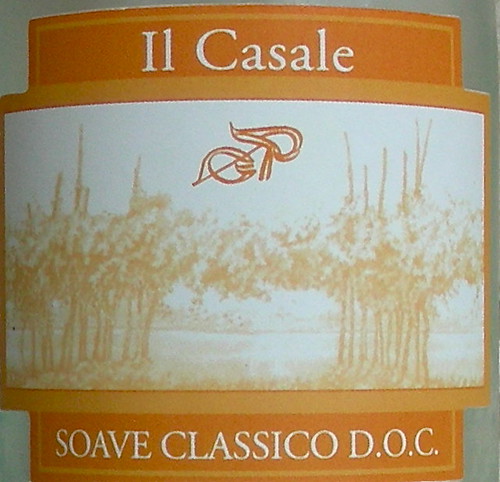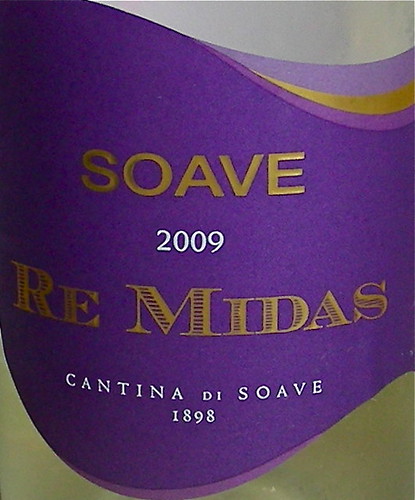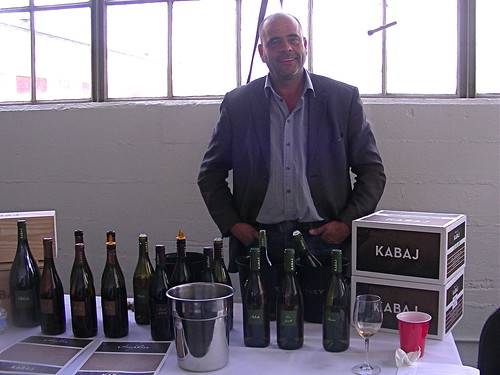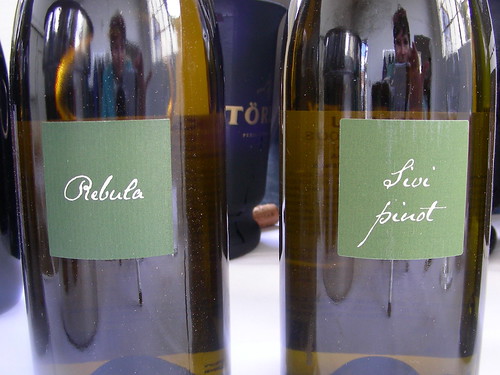At last month's Port4lio Tasting in San Francisco, I had the opportunity to taste some delicious white wines made from uncommon grapes. Here are the three that I found the most distinctive:
• 2010 Raventós i Blanc Silencis: the wine is 100% Xarel-lo, a Spanish grape variety from Catalonia. Although Xarel-lo is mainly used with Macabeu and Parellada in Cava production, it is sometimes used alone in still wines. Located in the Penedès wine region, south west of Barcelona, Bodegas Raventós i Blanc was founded in 1986 by Josep Raventós Blanc, a member of the Codorníu family. The family-run, quality-oriented winery owns 90 acres of vineyards, planted mostly to local varieties such as Macabeo, Xarel-lo, and Parellada, on rocky, chalky soil high in limestone content (like Champagne). The wine has a pale yellow color and a mineral nose of crushed seashells. On the palate, it is dry and quite earthy with a long distinctive finish.
• 2010 Trajarinho Vinho Verde: the wine is a blend of Trajadura and Alvarinho, two native grape varietals of the Iberian Peninsula. In Portugal, they are mainly found in the Vinho Verde region in the northern part of the country. Low in alcohol (11.5%), the wine has a light golden color and an attractive floral nose. On the palate, it is rather dry, slightly fizzy with lemon aromas and a refreshing finish.
• 2009 Bott Hárslevelu Határi: Hárslevelu is generally blended with Furmint to produce Tokaji Aszú in the Tokaj-Hegyalja region of Hungary but in this wine, it is vinified as a pure varietal dry wine. Határi is one of the top vineyards in Tokaj and the small, family-run Bott winery maintains 1.5 ha of vines there, planted on a rocky, volcanic terraced slope. The wine has a light yellow color and an unusual nose of aromatic herbs (thyme, rosemary). On the palate, it has a great mid-palate mouthfeel with notes of rose petal on the finish.
Technorati tags: wine food & drink
The smell of wine, oh how much more delicate, cheerful, gratifying, celestial and delicious it is than that of oil. François Rabelais (1495-1553)
Friday, June 24, 2011
Friday, June 10, 2011
Looking for a fresh summer wine? Try Soave
May was Soave Month in New York so as part of the promotion program, I received a couple of wine samples from Colangelo & Partners.
Maybe Italy's best wines are red but I really like its white wines, especially those that are fresh, crisp, fruity, as well as delicious with food.
Soave is (with Pinot Grigio) one of Italy's most popular white wines. It comes from the Veneto region in the northeast corner of Italy, the country's third biggest wine producer. The Soave growing area is situated in the hills east of Verona and is characterized by volcanic soils particularly rich in minerals. Garganega is Soave's principal grape variety and Italy's 6th most widely planted white grape.
 We first tasted the 2009 Il Casale Soave Classico produced by Azienda Agricola Le Albare. Le Albare is a small 6.5 hectare family estate planted with 100% Garganega grapes. it was founded at the turn of the 20th century by Adam Posenato, current winemaker Stefano Posenato's great-grandfather. The wine had a light golden color and a quite stony nose. On the palate, it was light-bodied with a crisp minerality and notes of citrus on the finish.
We first tasted the 2009 Il Casale Soave Classico produced by Azienda Agricola Le Albare. Le Albare is a small 6.5 hectare family estate planted with 100% Garganega grapes. it was founded at the turn of the 20th century by Adam Posenato, current winemaker Stefano Posenato's great-grandfather. The wine had a light golden color and a quite stony nose. On the palate, it was light-bodied with a crisp minerality and notes of citrus on the finish.
 We actually prefered our second sample, the 2009 Re Midas Soave. The wine is produced by Cantina di Soave, a cooperative founded in 1898 and made up of 2,200 winegrowers and farmers with currently 6,000 hectares under vine. The wine was named after Re (King) Midas who wished that everything he touched would turn to gold. Re Midas vineyards are located on the hillsides in the village of Soave at elevations between 100 and 350 meters. The wine is 100% Garganega aged 3 months in stainless steel followed by 1 month in bottle before release. it had a pale yellow color and a spicy nose with a touch of honey. On the palate, it was fuller and rounder than the Il Casale with aromas of fresh white peach. It was actually a very good accompaniment for our Cod with Lentils.
We actually prefered our second sample, the 2009 Re Midas Soave. The wine is produced by Cantina di Soave, a cooperative founded in 1898 and made up of 2,200 winegrowers and farmers with currently 6,000 hectares under vine. The wine was named after Re (King) Midas who wished that everything he touched would turn to gold. Re Midas vineyards are located on the hillsides in the village of Soave at elevations between 100 and 350 meters. The wine is 100% Garganega aged 3 months in stainless steel followed by 1 month in bottle before release. it had a pale yellow color and a spicy nose with a touch of honey. On the palate, it was fuller and rounder than the Il Casale with aromas of fresh white peach. It was actually a very good accompaniment for our Cod with Lentils.
Technorati tags: wine food & drink
Maybe Italy's best wines are red but I really like its white wines, especially those that are fresh, crisp, fruity, as well as delicious with food.
Soave is (with Pinot Grigio) one of Italy's most popular white wines. It comes from the Veneto region in the northeast corner of Italy, the country's third biggest wine producer. The Soave growing area is situated in the hills east of Verona and is characterized by volcanic soils particularly rich in minerals. Garganega is Soave's principal grape variety and Italy's 6th most widely planted white grape.
 We first tasted the 2009 Il Casale Soave Classico produced by Azienda Agricola Le Albare. Le Albare is a small 6.5 hectare family estate planted with 100% Garganega grapes. it was founded at the turn of the 20th century by Adam Posenato, current winemaker Stefano Posenato's great-grandfather. The wine had a light golden color and a quite stony nose. On the palate, it was light-bodied with a crisp minerality and notes of citrus on the finish.
We first tasted the 2009 Il Casale Soave Classico produced by Azienda Agricola Le Albare. Le Albare is a small 6.5 hectare family estate planted with 100% Garganega grapes. it was founded at the turn of the 20th century by Adam Posenato, current winemaker Stefano Posenato's great-grandfather. The wine had a light golden color and a quite stony nose. On the palate, it was light-bodied with a crisp minerality and notes of citrus on the finish. We actually prefered our second sample, the 2009 Re Midas Soave. The wine is produced by Cantina di Soave, a cooperative founded in 1898 and made up of 2,200 winegrowers and farmers with currently 6,000 hectares under vine. The wine was named after Re (King) Midas who wished that everything he touched would turn to gold. Re Midas vineyards are located on the hillsides in the village of Soave at elevations between 100 and 350 meters. The wine is 100% Garganega aged 3 months in stainless steel followed by 1 month in bottle before release. it had a pale yellow color and a spicy nose with a touch of honey. On the palate, it was fuller and rounder than the Il Casale with aromas of fresh white peach. It was actually a very good accompaniment for our Cod with Lentils.
We actually prefered our second sample, the 2009 Re Midas Soave. The wine is produced by Cantina di Soave, a cooperative founded in 1898 and made up of 2,200 winegrowers and farmers with currently 6,000 hectares under vine. The wine was named after Re (King) Midas who wished that everything he touched would turn to gold. Re Midas vineyards are located on the hillsides in the village of Soave at elevations between 100 and 350 meters. The wine is 100% Garganega aged 3 months in stainless steel followed by 1 month in bottle before release. it had a pale yellow color and a spicy nose with a touch of honey. On the palate, it was fuller and rounder than the Il Casale with aromas of fresh white peach. It was actually a very good accompaniment for our Cod with Lentils.Technorati tags: wine food & drink
Wednesday, June 01, 2011
The wines of Slovenian producer Kabaj: intertwining modernity with tradition
A couple of weeks ago, I was invited to Port4lio at the historic Fort Mason firehouse in San Francisco, an annual tasting event featuring wines imported by Blue Danube Wine Company, Return to Terroir, and Vinos Unico. This year, the event prominently featured French winemaker Jean-Michel Morel presenting his Slovenian wines for the first time in the US.

Jean-Michel Morel of Kabaj winery
With his wife Katja Kabaj, Jean-Michel Morel is the owner of Kabaj, a winery located in Goriška Brda, a wine-growing region in western Slovenia, near the Italian border. It was one of the first regions in Slovenia to establish an international reputation for the quality of its wines. Thanks to the Adriatic sea, the area enjoys a Mediterranean climate with constant dry winds called "Bura" that reduces the need for fungicides and pesticides. The soil is principally composed of ocean sediment and is rich in marlstone, slate claystone, and limestone.
The Kabaj family has farmed vineyards in Goriška Brda for generations and used to sell their grapes to the Yugoslav state. But in the early 1990s, Katja Kabaj and Jean-Michel Morel decided to release their own wines under the Kabaj family name. They own 55,000 vines farmed sustainably and fertilized with horse manure, 70% of which are white varieties, including indigenous Rebula (Ribolla Gialla), Sauvignonasse (Tokai Fruilano), and Malvasia Istriana. Red grape varieties are also grown, mostly Merlot, Cabernet Franc, and Petit Verdot. The winery has a modern cellar built a few years ago.

I tasted the folowing wines:
• 2008 Kabaj Sivi Pinot: 100% Pinot Grigio, aged 12 months in French oak barrel, followed by 4 months in bottle. Yellow color, floral acacia nose, medium bodied on the palate, less acidic than a Italian Pinot Grigio.
• 2008 Kabaj Ravan: 100% Tokai Fruilano also known as Sauvignon Vert or Sauvignonasse, a grape variety believed to have originated in the Veneto region. Aged 12 months in French oak barrel, followed by 4 months in bottle. Yellow color, floral nose, soft on the palate with fresh peach aromas.
• 2008 Kabaj Rebula: 100% Ribolla Gialla, a white grape variety mostly found in the Friuli-Venezia-Giulia region of northeast Italy and in Slovenia where it has been grown since the 13th century. The wine is fermented on the skins for 30 days then aged 12 months in French oak barrel, followed by 4 months in bottle. Golden color, aromatic nose of herbs and mineral notes. Quite spicy and complex on the palate. My favorite among the whites.
• 2006 Kabaj Cuvée Morel: 60% Merlot, 18% Cabernet Sauvignon, 18% Cabernet Franc, and 4% Petit Verdot. Aged 36 months in French oak barrels then 4 months in bottles. Dark garnet color, nose of dry herbs, medium-bodied, some tannins on the palate, needs to open up.
• 2007 Kabaj Merlot: 100% Merlot. Aged 24 months in French oak barrels then 4 months in bottles. Dark color, aromatic nose, aromas of blackberries and cherries, medium-bodied, quite dry with some tannins. Not jammy at all but more fruity than the Cuvée Morel, very food friendly.
The last 3 wines of the tasting were the most interesting and intriguing. They were vinified and aged in 3000 liter clay jars buried underground called kvevri, using ancient Georgian winemaking practices. After being aged in the jars for 10 months on the skins, the wine goes without the skins into oak barrels for 12 months and aged for 12 additional months in bottle. During aging, 25% of the wine is usually lost to evaporation.
• 2005 Kabaj Amfora: dark yellow color, floral nose, concentrated and tight on the palate, not really fruity, rather spicy and quite complex.
• 2006 Kabaj Amfora: much more open than the 2005. Nice floral nose and additional notes of peach and apricots. Quite distinguished and really delicious.
• 2007 Kabaj Amfora: more austere than the 2006, similar in style to the 2005.
Technorati tags: wine food & drink

Jean-Michel Morel of Kabaj winery
With his wife Katja Kabaj, Jean-Michel Morel is the owner of Kabaj, a winery located in Goriška Brda, a wine-growing region in western Slovenia, near the Italian border. It was one of the first regions in Slovenia to establish an international reputation for the quality of its wines. Thanks to the Adriatic sea, the area enjoys a Mediterranean climate with constant dry winds called "Bura" that reduces the need for fungicides and pesticides. The soil is principally composed of ocean sediment and is rich in marlstone, slate claystone, and limestone.
The Kabaj family has farmed vineyards in Goriška Brda for generations and used to sell their grapes to the Yugoslav state. But in the early 1990s, Katja Kabaj and Jean-Michel Morel decided to release their own wines under the Kabaj family name. They own 55,000 vines farmed sustainably and fertilized with horse manure, 70% of which are white varieties, including indigenous Rebula (Ribolla Gialla), Sauvignonasse (Tokai Fruilano), and Malvasia Istriana. Red grape varieties are also grown, mostly Merlot, Cabernet Franc, and Petit Verdot. The winery has a modern cellar built a few years ago.

I tasted the folowing wines:
• 2008 Kabaj Sivi Pinot: 100% Pinot Grigio, aged 12 months in French oak barrel, followed by 4 months in bottle. Yellow color, floral acacia nose, medium bodied on the palate, less acidic than a Italian Pinot Grigio.
• 2008 Kabaj Ravan: 100% Tokai Fruilano also known as Sauvignon Vert or Sauvignonasse, a grape variety believed to have originated in the Veneto region. Aged 12 months in French oak barrel, followed by 4 months in bottle. Yellow color, floral nose, soft on the palate with fresh peach aromas.
• 2008 Kabaj Rebula: 100% Ribolla Gialla, a white grape variety mostly found in the Friuli-Venezia-Giulia region of northeast Italy and in Slovenia where it has been grown since the 13th century. The wine is fermented on the skins for 30 days then aged 12 months in French oak barrel, followed by 4 months in bottle. Golden color, aromatic nose of herbs and mineral notes. Quite spicy and complex on the palate. My favorite among the whites.
• 2006 Kabaj Cuvée Morel: 60% Merlot, 18% Cabernet Sauvignon, 18% Cabernet Franc, and 4% Petit Verdot. Aged 36 months in French oak barrels then 4 months in bottles. Dark garnet color, nose of dry herbs, medium-bodied, some tannins on the palate, needs to open up.
• 2007 Kabaj Merlot: 100% Merlot. Aged 24 months in French oak barrels then 4 months in bottles. Dark color, aromatic nose, aromas of blackberries and cherries, medium-bodied, quite dry with some tannins. Not jammy at all but more fruity than the Cuvée Morel, very food friendly.
The last 3 wines of the tasting were the most interesting and intriguing. They were vinified and aged in 3000 liter clay jars buried underground called kvevri, using ancient Georgian winemaking practices. After being aged in the jars for 10 months on the skins, the wine goes without the skins into oak barrels for 12 months and aged for 12 additional months in bottle. During aging, 25% of the wine is usually lost to evaporation.
• 2005 Kabaj Amfora: dark yellow color, floral nose, concentrated and tight on the palate, not really fruity, rather spicy and quite complex.
• 2006 Kabaj Amfora: much more open than the 2005. Nice floral nose and additional notes of peach and apricots. Quite distinguished and really delicious.
• 2007 Kabaj Amfora: more austere than the 2006, similar in style to the 2005.
Technorati tags: wine food & drink
Subscribe to:
Comments (Atom)